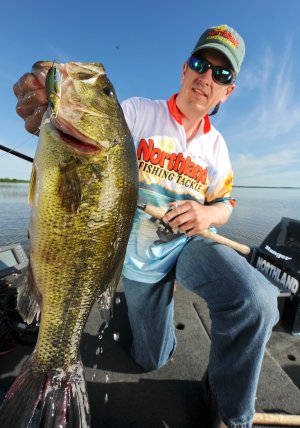
Weedless spoons like the Live-Forage Weedless Spoon are overlooked tools for sloppin’ hawg bass.
Yes, a fork typically works better when eating greens. Not so, however, when chasing largemouth bass in the “salad”. Weedless spoons are tailor-made for such terrain, specifically designed to go where no other top-waters dare. When a bass blast one of these baits, the fun has just begun. A tug-o-war ensues that results in an adrenaline rush like no other in bass fishing.
I carry an assortment of JawBreaker Spoons in my “slop-box.” These ½ ounce-skirted weedless spoons were designed and refined about thirty years ago by my uncle and dad, John and Duane Peterson. At the time, they were really focused on learning all they could about catching largemouth while expanding Northland Tackle’s product line. They realized that many bass lived back in the thickest stuff. Trolling motors then were not very effective at pulling a boat through the cover. They generally settled for working their boats along the edge of shallow cover. The JawBreaker allowed them to make long casts, way back into mats of lily pads, dollar pads, and wild rice. They were able to reach fish that many anglers were not able to get to. The JawBreaker casts well, is virtually impossible to get hung up, and continues to produce through-the-roof strikes from big bass. Here’s the simple scoop. Cast it out and begin to retrieve the spoon as soon as it hits the surface. With the rod positioned at 11 o’clock, retrieve the lure just fast enough to keep it on the surface. The spoon will slither and wobble as it deflects against and over the vegetation. I use a steady retrieve all the way back to the boat and fire away again. I said it was simple! Silver shiner and gold shiner patterns are productive for bright days while black shiner is a good bet on overcast days.
Thirty years later, Northland Fishing Tackle has added a new weedless spoon to its line-up. The Live-Forage Weedless Spoon is another brass spoon but sports a high-definition photo finish that replicates various forage types. The silver shiner pattern actually looks like a shiner minnow. The bluegill, bullfrog, and baby bass patterns are some of my favorites. I’ll often add a 4-inch Slurpies Swim’n Grub as a trailer. This gives the spoons a little “lift” in the water, allowing them to stay on the surface with a slower retrieve.
Heavy gear is necessary for top-water sloppin’. For spoon sticks, I use St. Croix Avid flippin’ sticks paired with ABU Garcia’s Revo high-speed casting reels. A heavy braided line is a must as well. I like the 65 -80 pound tests. Remember, we are talking about winching bass, at times close to 50 yards, through some nasty cover.
Hawgs in a Haystack
Some anglers might look at a large area of emergent vegetation as a haystack, the bass being the needle. Anglers can tip the odds in their favor by staying stealthy, reading the cover, and casting accordingly, rather than at random.
Keep noise to a minimum. Use any breeze to push the boat around and through the cover. I like to let the boat sit on the cover for a while I fan cast around the boat. Then, I’ll kick the MinnKota in high gear for a short amount of time and let the boat coast into new water.
Start with small patches of cover as they are easier to probe thoroughly and yield more bass per acre. Position the boat close to or within the cover so that on each cast, the lure remains in the cover all the way to the boat.
Within larger fields of cover, lush vegetation holds more forage and bass than stale or dying vegetation. Savvy slop anglers look for vegetation that “glows” green. It’s simply brighter than the adjacent cover. Look for greener pastures.
Irregularities in the vegetation are key too. Look for a log within the vegetation, a hole in the mat, or a mix of weed types. While bass are often located in the shallowest cover early in the season, deep edges of matted vegetation are often hot spots by mid-summer. Here, water tends to be more oxygenated than the dead center of the mat. Big bass especially seems to be set up under mats with easy access to deeper water.
Missed fish is a common excuse for anglers to leave their spoons and frogs in the box. With some patience, practice, and the proper equipment, however, I believe that hooking percentages can be as good or better with slop top-waters than with conventional open-water surface lures. When a bass comes through the roof for a weedless topwater, drop the rod tip while picking up the slack. Set the hook hard and crank the fish in rapidly. Anything less will result in lost fish.
Bass anglers agree that nothing beats a top-water strike from a bulldozer bass. Add the element of thick emergent vegetation and we are talking adrenaline rush from strike to lip-lock. While some anglers avoid weeds, others dream of fields of matted vegetation, explosive strikes, and wild struggles with bruiser bass. They seek out the greenest matted vegetation they can find and go to work. Is your slop-box ready for the rush?

